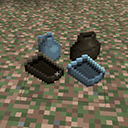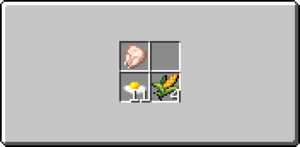Difference between revisions of "User:Morganiq/Ceramics"
(Initial draft; about 50% complete.) |
Kittychanley (Talk | contribs) m (Wanted Image Cleanup) |
||
| (7 intermediate revisions by one other user not shown) | |||
| Line 1: | Line 1: | ||
| − | Ceramic items become useful early in the game, and crafting them begins the progression from the [[Stone Age]] to the [[Bronze Age]]. Items of '''pottery''' (the jug and vessel) remain useful throughout the game, whereas '''molds''' used for [[casting]] tools and weapons are eventually superseded by [[smithing]]. | + | [[File:PlacedPottery.png|thumb|Several placed soft clay (blue) and hardened ceramic (brown) items.]] |
| + | |||
| + | '''Ceramic''' items become useful early in the game, and crafting them begins the progression from the [[User:morganiq/Technology#Stone Age|Stone Age]] to the [[User:morganiq/Technology#Bronze Age|Bronze Age]]. Items of '''pottery''' (the jug and vessel) remain useful throughout the game, whereas '''shaped molds''', which are used for [[User:morganiq/Casting|casting]] tools and weapons during the Bronze Age, are eventually superseded by the use of '''unshaped molds''', which cast ingots for use in [[User:morganiq/Smithing|smithing]] during the [[User:morganiq/Technology#Iron Age|Iron Age]]. | ||
Ceramic items are initially crafted out of '''clay'''. These clay items are soft and useless until ''fired'' (heated at a high temperature) to harden them into '''ceramics'''. Firing is done in a '''pit kiln''', an uncrafted structure built in the world. | Ceramic items are initially crafted out of '''clay'''. These clay items are soft and useless until ''fired'' (heated at a high temperature) to harden them into '''ceramics'''. Firing is done in a '''pit kiln''', an uncrafted structure built in the world. | ||
| − | + | Both soft clay and hard ceramic items may be '''placed''' on any solid block by sneaking (default: {{key|Shift}}) and right-clicking while holding the item. Up to four items may be placed on a single block, one in each corner. Placed items float above the block and spin slowly, similar to a dropped item, except that they do not despawn. To retrieve a placed item, "un-place" it by sneak-right-clicking it again. Multiple placed items in a single block may be collected all at once by breaking the block they're in. Item placing is useful for storing goods in vessels, and it is necessary to place unfired clay items in the pit kiln. | |
| − | Both soft clay and hard ceramic items may be '''placed''' on any solid block by sneaking (default: {{key|Shift}}) and right-clicking while holding the item. Up to four items may be placed on a single block, one in each corner. Placed items float above the block and spin slowly, similar to a dropped item, except that they do not despawn | + | |
= Clay forming = | = Clay forming = | ||
| Line 12: | Line 13: | ||
Note that unlike crafting, but like knapping, the material is consumed ''at the time the interface is brought up'', not at the time an object is dragged out. This means 5 clay will ''always'' be consumed by the interface, whether or not a clay object was produced. | Note that unlike crafting, but like knapping, the material is consumed ''at the time the interface is brought up'', not at the time an object is dragged out. This means 5 clay will ''always'' be consumed by the interface, whether or not a clay object was produced. | ||
| − | In the case of the knife, while two blades can be knapped from the same stone, only a single blade may be molded. | + | In the case of the knife, while two blades can be knapped from the same stone, only a single blade may be molded. However, similar to knapping, some mold patterns can be shifted a block left, right, up, or down, so long as the shape of the hollowed-out space remains the same and a border remains to hold the liquid. (Patterns which unavoidably stretch to the edges are still considered to hold liquid.) |
== Pottery recipes == | == Pottery recipes == | ||
| Line 21: | Line 22: | ||
|- | |- | ||
|{{Knapping | |{{Knapping | ||
| − | |A1= | + | |A1= CFD|B1= CFL, CFD |C1= CFD|D1= CFD, CFL |E1= CFD |
| − | |A2= | + | |A2= CFL, CFD|B2= CFL|C2= CFL|D2= CFL |E2= CFD, CFL |
| − | |A3= | + | |A3= CFL|B3= CFL, CFD|C3= CFL|D3= CFD, CFL |E3= CFL |
| − | |A4= | + | |A4= CFL, CFD|B4= CFL|C4= CFL|D4= CFL |E4= CFD, CFL |
| − | |A5= | + | |A5= CFL, CFD|B5= CFL, CFD|C5= CFL|D5= CFD, CFL |E5= CFD, CFL |
|Output= Clay Jug | |Output= Clay Jug | ||
}} | }} | ||
|{{Knapping | |{{Knapping | ||
| − | |A1= | + | |A1= CFD|B1= CFL|C1= CFL|D1= CFL |E1= CFD |
| − | |A2= | + | |A2= CFL|B2= CFL|C2= CFL|D2= CFL |E2= CFL |
| − | |A3= | + | |A3= CFL|B3= CFL|C3= CFL|D3= CFL |E3= CFL |
| − | |A4= | + | |A4= CFL|B4= CFL|C4= CFL|D4= CFL |E4= CFL |
| − | |A5= | + | |A5= CFD|B5= CFL|C5= CFL|D5= CFL|E5= CFD |
|Output= Clay Vessel | |Output= Clay Vessel | ||
}} | }} | ||
|} | |} | ||
| − | |||
== Mold recipes == | == Mold recipes == | ||
| − | === Unshaped mold === | + | === Unshaped (ingot) mold === |
{| cellspacing="10" | {| cellspacing="10" | ||
| Line 47: | Line 47: | ||
|- | |- | ||
|{{Knapping | |{{Knapping | ||
| − | |A1= | + | |A1= CFL|B1= CFL|C1= CFL|D1= CFL |E1= CFL |
| − | |A2= | + | |A2= CFL|B2= CFD, CFL|C2= CFD|D2= CFL, CFD |E2= CFL |
| − | |A3= | + | |A3= CFL|B3= CFD, CFL|C3= CFD|D3= CFL, CFD |E3= CFL |
| − | |A4= | + | |A4= CFL|B4= CFD, CFL|C4= CFD|D4= CFL, CFD |E4= CFL |
| − | |A5= | + | |A5= CFL|B5= CFL|C5= CFL|D5= CFL|E5= CFL |
|Output= Clay Mold, 2 | |Output= Clay Mold, 2 | ||
}} | }} | ||
| Line 64: | Line 64: | ||
|- | |- | ||
|{{Knapping | |{{Knapping | ||
| − | |A1= | + | |A1= CFL|B1= CFD, CFL|C1= CFL|D1= CFL, CFD |E1= CFL |
| − | |A2= | + | |A2= CFD, CFL|B2= CFD |C2= CFD |D2= CFD |E2= CFL, CFD |
| − | |A3= | + | |A3= CFD |B3= CFD |C3= CFD |D3= CFD |E3= CFD |
| − | |A4= | + | |A4= CFD, CFL|B4= CFD |C4= CFD |D4= CFD |E4= CFL, CFD |
| − | |A5= | + | |A5= CFL|B5= CFD, CFL|C5= CFL|D5= CFL, CFD |E5=CFL |
|Output= Clay Mold Axe | |Output= Clay Mold Axe | ||
}} | }} | ||
|{{Knapping | |{{Knapping | ||
| − | |A1= | + | |A1= CFL|B1= CFL|C1= CFD|D1= CFL |E1= CFL |
| − | |A2= | + | |A2= CFL|B2= CFL|C2= CFD|D2= CFL |E2= CFL |
| − | |A3= | + | |A3= CFL|B3= CFL|C3= CFD|D3= CFL |E3= CFL |
| − | |A4= | + | |A4= CFL|B4= CFL|C4= CFD|D4= CFL |E4= CFL |
| − | |A5= | + | |A5= CFL|B5= CFL|C5= CFD|D5= CFL |E5= CFL |
|Output= Clay Mold Chisel | |Output= Clay Mold Chisel | ||
}} | }} | ||
|{{Knapping | |{{Knapping | ||
| − | |A1= | + | |A1= CFL|B1= CFL|C1= CFL|D1= CFL |E1= CFL |
| − | |A2= | + | |A2= CFD|B2= CFD|C2= CFD|D2= CFD |E2= CFD |
| − | |A3= | + | |A3= CFD|B3= CFD|C3= CFD|D3= CFD |E3= CFD |
| − | |A4= | + | |A4= CFL|B4= CFL|C4= CFD|D4= CFL |E4= CFL |
| − | |A5= | + | |A5= CFL|B5= CFL|C5= CFL|D5= CFL |E5= CFL |
|Output= Clay Mold Hammer | |Output= Clay Mold Hammer | ||
}} | }} | ||
| Line 95: | Line 95: | ||
|- | |- | ||
|{{Knapping | |{{Knapping | ||
| − | |A1= | + | |A1= CFL|B1= CFL|C1= CFL|D1= CFL |E1= CFL |
| − | |A2= | + | |A2= CFD|B2= CFD|C2= CFD|D2= CFD |E2= CFD |
| − | |A3= | + | |A3= CFL, CFD|B3= CFL, CFD|C3= CFL|D3= CFD, CFL |E3= CFD, CFL |
| − | |A4= | + | |A4= CFL|B4= CFL|C4= CFL|D4= CFL |E4= CFL |
| − | |A5= | + | |A5= CFL|B5= CFL|C5= CFL|D5= CFL |E5= CFL |
|Output= Clay Mold Hoe | |Output= Clay Mold Hoe | ||
}} | }} | ||
|{{Knapping | |{{Knapping | ||
| − | |A1= | + | |A1= CFL |B1= CFL |C1= CFD |D1= CFL |E1= CFL |
| − | |A2= | + | |A2= CFL |B2= CFL, CFD |C2= CFD |D2= CFD, CFL |E2= CFL |
| − | |A3= | + | |A3= CFL |B3= CFL, CFD |C3= CFD |D3= CFD, CFL |E3= CFL |
| − | |A4= | + | |A4= CFL |B4= CFL, CFD |C4= CFD |D4= CFD, CFL |E4= CFL |
| − | |A5= | + | |A5= CFL |B5= CFL, CFD |C5= CFD |D5= CFD, CFL |E5= CFL |
|Output= Clay Mold Knife | |Output= Clay Mold Knife | ||
}} | }} | ||
|{{Knapping | |{{Knapping | ||
| − | |A1= | + | |A1= CFL |B1= CFL |C1= CFL |D1= CFL |E1= CFL |
| − | |A2= | + | |A2= CFL |B2= CFD |C2= CFD |D2= CFD |E2= CFL |
| − | |A3= | + | |A3= CFD |B3= CFL |C3= CFL |D3= CFL |E3= CFD |
| − | |A4= | + | |A4= CFL |B4= CFL |C4= CFL |D4= CFL |E4= CFL |
| − | |A5= | + | |A5= CFL |B5= CFL |C5= CFL |D5= CFL |E5= CFL |
|Output= Clay Mold Pick | |Output= Clay Mold Pick | ||
}} | }} | ||
| Line 126: | Line 126: | ||
|- | |- | ||
|{{Knapping | |{{Knapping | ||
| − | |A1= | + | |A1= CFL |B1= CFL |C1= CFL |D1= CFL |E1= CFL |
| − | |A2= | + | |A2= CFL, CFD |B2= CFD |C2= CFD |D2= CFD |E2= CFD, CFL |
| − | |A3= | + | |A3= CFD |B3= CFL |C3= CFL |D3= CFL |E3= CFD |
| − | |A4= | + | |A4= CFL, CFD |B4= CFL |C4= CFL |D4= CFL |E4= CFD, CFL |
| − | |A5= | + | |A5= CFL |B5= CFL |C5= CFL |D5= CFL |E5= CFL |
|Output= Clay Mold ProPick | |Output= Clay Mold ProPick | ||
}} | }} | ||
|{{Knapping | |{{Knapping | ||
| − | |A1= | + | |A1= CFD, CFL |B1= CFD, CFL |C1= CFL|D1= CFL, CFD|E1=CFL, CFD |
| − | |A2= | + | |A2= CFD, CFL |B2= CFD, CFL |C2= CFD |D2=CFL, CFD |E2=CFL, CFD |
| − | |A3= | + | |A3= CFL|B3= CFD |C3= CFD |D3= CFD |E3= CFL |
| − | |A4= | + | |A4= CFL, CFD|B4= CFD |C4= CFD |D4= CFD |E4= CFD, CFL |
| − | |A5= | + | |A5= CFL, CFD|B5=CFL, CFD |C5= CFL|D5= CFD, CFL |E5= CFD, CFL |
|Output= Clay Mold Saw | |Output= Clay Mold Saw | ||
}} | }} | ||
|{{Knapping | |{{Knapping | ||
| − | |A1= | + | |A1= CFL|B1= CFL|C1= CFL|D1= CFL|E1=CFL |
| − | |A2= | + | |A2= CFD, CFL |B2= CFD |C2= CFD |D2= CFD |E2= CFL, CFD |
| − | |A3= | + | |A3= CFL, CFD|B3= CFD |C3= CFD |D3= CFD |E3= CFD, CFL |
| − | |A4= | + | |A4= CFL, CFD|B4= CFL, CFD|C4= CFL|D4= CFD, CFL |E4= CFD, CFL |
| − | |A5= | + | |A5= CFL|B5= CFL|C5= CFL|D5= CFL|E5=CFL |
|Output= Clay Mold Scythe | |Output= Clay Mold Scythe | ||
}} | }} | ||
| Line 155: | Line 155: | ||
|- | |- | ||
|{{Knapping | |{{Knapping | ||
| − | |A1= | + | |A1= CFL |B1= CFD |C1= CFD |D1= CFD |E1=CFL |
| − | |A2= | + | |A2= CFL |B2= CFD |C2= CFD |D2= CFD |E2=CFL |
| − | |A3= | + | |A3= CFL|B3= CFD |C3= CFD |D3= CFD |E3=CFL |
| − | |A4= | + | |A4= CFL|B4= CFD |C4= CFD|D4= CFD |E4=CFL |
| − | |A5= | + | |A5= CFL|B5= CFL|C5= CFD |D5=CFL |E5=CFL |
|Output= Clay Mold Shovel | |Output= Clay Mold Shovel | ||
}} | }} | ||
| Line 172: | Line 172: | ||
|- | |- | ||
|{{Knapping | |{{Knapping | ||
| − | |A1= | + | |A1= CFL |B1= CFL |C1= CFD |D1= CFL |E1= CFL |
| − | |A2= | + | |A2= CFL |B2= CFD |C2= CFD |D2= CFD |E2= CFL |
| − | |A3= | + | |A3= CFL |B3= CFD |C3= CFD |D3= CFD |E3= CFL |
| − | |A4= | + | |A4= CFL |B4= CFD |C4= CFD |D4= CFD |E4= CFL |
| − | |A5= | + | |A5= CFL |B5= CFL |C5= CFD |D5= CFL |E5= CFL |
|Output= Clay Mold Mace | |Output= Clay Mold Mace | ||
}} | }} | ||
|{{Knapping | |{{Knapping | ||
| − | |A1= | + | |A1= CFD, CFL |B1= CFD, CFL |C1= CFD |D1= CFL, CFD |E1= CFL, CFD |
| − | |A2= | + | |A2= CFD, CFL |B2= CFD |C2= CFD |D2= CFD |E2= CFL, CFD |
| − | |A3= | + | |A3= CFD |B3= CFD |C3= CFD |D3= CFD |E3= CFD |
| − | |A4= | + | |A4= CFL, CFL |B4= CFD |C4= CFD |D4= CFD |E4= CFL, CFL |
| − | |A5= | + | |A5= CFL, CFL |B5= CFL, CFL |C5= CFD |D5= CFL, CFL |E5= CFL, CFL |
|Output= Clay Mold Javelin | |Output= Clay Mold Javelin | ||
}} | }} | ||
|{{Knapping | |{{Knapping | ||
| − | |A1= | + | |A1= CFL, CFD|B1= CFL, CFD|C1= CFL |D1= CFD, CFL |E1= CFD, CFL |
| − | |A2= | + | |A2= CFL, CFD|B2= CFL, CFD|C2= CFD |D2= CFD, CFL |E2= CFD, CFL |
| − | |A3= | + | |A3= CFL|B3= CFD |C3= CFD |D3= CFD |E3= CFL |
| − | |A4= | + | |A4= CFL|B4= CFD, CFL |C4= CFD |D4= CFL, CFD|E4= CFL |
| − | |A5= | + | |A5= CFD, CFL |B5= CFL|C5= CFL |D5= CFL|E5= CFL, CFD |
|Output= Clay Mold Sword | |Output= Clay Mold Sword | ||
}} | }} | ||
|} | |} | ||
| − | = Firing | + | = Firing = |
Clay objects are soft, and of no use until they are ''fired'' (heated at a high temperature) in a '''pit kiln''' to harden them into ceramics. | Clay objects are soft, and of no use until they are ''fired'' (heated at a high temperature) in a '''pit kiln''' to harden them into ceramics. | ||
| Line 203: | Line 203: | ||
'''Required resources:''' | '''Required resources:''' | ||
*8 [[straw]] | *8 [[straw]] | ||
| − | |||
*8 [[logs]] | *8 [[logs]] | ||
| − | *1 [[ | + | *1 or more [[firestarters]] or [[Metals#Flint_.26_Steel|flint & steel]] |
| − | *up to 4 clay items to be fired | + | *up to 4 soft clay items to be fired |
| + | |||
| + | ''Straw is obtained by breaking 1-high grass with a [[knife]] or [[scythe]]. It is also a byproduct of [[Agriculture#Refining|refining grains]].'' | ||
'''Building a pit kiln:''' | '''Building a pit kiln:''' | ||
| Line 217: | Line 218: | ||
#Place 8 logs on top of the straw. The logs will fill the remaining space. | #Place 8 logs on top of the straw. The logs will fill the remaining space. | ||
#: ''As with straw, the logs must be placed by right-clicking '''only'''.'' | #: ''As with straw, the logs must be placed by right-clicking '''only'''.'' | ||
| − | #Light the logs using a [[firestarter]] or [[flint & steel]]. | + | #Light the logs using a [[firestarter]] or [[Metals#Flint_.26_Steel|flint & steel]]. (It may take several attempts.) |
| − | The pit kiln will burn for 8 hours. When the fire burns out, individual ceramic items may be un-placed by sneak-right-clicking, or the entire set of fired items may be collected in one step by breaking the block they're placed in. | + | The pit kiln will burn for 8 in-game hours. When the fire burns out, individual ceramic items may be un-placed by sneak-right-clicking, or the entire set of fired items may be collected in one step by breaking the block they're placed in. |
{| class="wikitable" | {| class="wikitable" | ||
| Line 245: | Line 246: | ||
|} | |} | ||
| + | = Ceramic items = | ||
| − | + | Finished ceramic items include '''pottery''' items, which are used for storage, and '''molds''', which are used in [[User:morganiq/Casting|casting]] of tools, weapons, and metal ingots. | |
| − | + | ||
| − | + | ||
| − | + | ||
| − | + | Each time a ceramic item is used, there is a chance of it breaking; this chance is different for each type of item. | |
| − | + | == Pottery == | |
| − | + | ||
| − | + | ||
| − | + | ||
| − | + | ||
| − | + | ||
| − | + | ||
| − | + | ||
| − | + | ||
| − | + | ||
| − | == | + | === [[File:Grid_Ceramic_Jug.png|link=|A ceramic jug]] Jug === |
| − | + | The jug is used to carry water to quench the Player's thirst. It can be filled by right-clicking on a block of ''still [[fresh water]]'' (flowing water and salt water will not work), or by placing it in a [[water barrel]] set to ''out''. Right-clicking while holding the jug will consume the water in it, replenishing three bars of thirst and completely emptying the jug. Jugs occasionally need to be replaced, as there is a very small chance that the jug will break on each use. | |
| − | + | === [[File:Grid_Ceramic_Vessel.png|link=|A ceramic vessel]] Vessel === | |
| − | + | :''Main article: [[User:morganiq/Smelting|Smelting]]'' | |
| − | The | + | The vessel is a container used both for storage of small items and as an essential component of [[User:morganiq/Smelting|smelting]] and [[User:morganiq/Casting|casting]] of Bronze Age metals. |
| − | + | [[File:VesselFilled.png|thumb|A ceramic vessel filled with small items]] | |
| + | As a simple storage container, it will hold up to 4 stacks of items whose sizes are either ''small'', ''very small'', or ''tiny''. To view a vessel's contents, right-click while holding it; this brings up the inventory screen, and items may be added or removed as with a [[chest]]. | ||
| − | + | A vessel can be stored in a chest or carried in the Player's inventory, even when it contains items. As such it be used to extend both the Player's inventory and the inventory of chests by condensing four stacks into one. | |
| − | + | As with other ceramic items, vessels can be placed on solid blocks, or un-placed from blocks, by sneak-right-clicking. This is a useful storage technique, especially early in the game before the Player has obtained a [[saw]] to create a [[chest]]. | |
| − | + | Vessels are particularly useful for storing [[food]] items, which will decay at 50% of the normal rate when stored in a vessel. | |
| − | + | == Molds == | |
| − | + | :''Main article: [[User:morganiq/Casting|Casting]]'' | |
| − | [[ | + | Molds are used to [[User:morganiq/Casting|cast]] liquid metal into a solid form. There are two types of mold, ''shaped'' and ''unshaped''. Shaped molds are those which have the shape of a tool or weapon, and are used to cast the corresponding item during the [[Bronze Age]]. Unshaped molds simply form [[ingots]], which are used to [[User:morganiq/Smithing|smith]] tools, weapons, and [[armor]] during the [[User:morganiq/Technology#Iron Age|Iron Age]]. See ''[[User:morganiq/Smelting|Smelting]]'' and ''[[User:morganiq/Casting|Casting]]'' for more information about casting with molds. |
| − | = | + | = [[Configuration]] = |
| − | + | {| class="wikitable" | |
| − | + | |- | |
| − | + | ! Option | |
| − | + | ! Default<br>Value | |
| − | + | ! Description | |
| − | + | |- | |
| − | + | | {{TFCOptionGroup|general| |Miscellaneous options.}} | |
| − | + | |- | |
| − | + | | {{TFCOptionVar|pitKilnBurnTime|8|The number of hours that the pit kiln should burn before being completed.}} | |
| − | + | ||
| − | + | ||
| − | + | ||
| − | + | ||
| − | + | ||
| − | + | ||
| − | + | ||
| − | + | ||
| − | + | ||
| − | + | ||
| − | + | ||
| − | + | ||
| − | + | ||
| − | + | ||
| − | + | ||
| − | + | ||
| − | + | ||
| − | + | ||
| − | + | ||
| − | + | ||
| − | + | ||
| − | + | ||
| − | + | ||
| − | + | ||
| − | + | ||
| − | + | ||
| − | + | ||
| − | + | ||
| − | + | ||
| − | + | ||
| − | + | ||
| − | + | ||
| − | + | ||
| − | + | ||
| − | + | ||
| − | + | ||
| − | + | ||
| − | + | ||
| − | + | ||
| − | + | ||
| − | + | ||
| − | + | ||
| − | |{{ | + | |
| − | | | + | |
| − | | | + | |
| − | + | ||
| − | | | + | |
| − | + | ||
| − | + | ||
| − | + | ||
| − | }} | + | |
|} | |} | ||
| − | |||
| − | |||
| − | |||
| − | |||
| − | |||
| − | |||
| − | |||
| − | |||
| − | |||
| − | |||
| − | |||
| − | |||
| − | |||
| − | |||
| − | |||
| − | |||
| − | |||
| − | |||
| − | |||
| − | |||
| − | |||
| − | |||
| − | |||
Latest revision as of 04:46, 9 June 2015
Ceramic items become useful early in the game, and crafting them begins the progression from the Stone Age to the Bronze Age. Items of pottery (the jug and vessel) remain useful throughout the game, whereas shaped molds, which are used for casting tools and weapons during the Bronze Age, are eventually superseded by the use of unshaped molds, which cast ingots for use in smithing during the Iron Age.
Ceramic items are initially crafted out of clay. These clay items are soft and useless until fired (heated at a high temperature) to harden them into ceramics. Firing is done in a pit kiln, an uncrafted structure built in the world.
Both soft clay and hard ceramic items may be placed on any solid block by sneaking (default: ⇧ Shift) and right-clicking while holding the item. Up to four items may be placed on a single block, one in each corner. Placed items float above the block and spin slowly, similar to a dropped item, except that they do not despawn. To retrieve a placed item, "un-place" it by sneak-right-clicking it again. Multiple placed items in a single block may be collected all at once by breaking the block they're in. Item placing is useful for storing goods in vessels, and it is necessary to place unfired clay items in the pit kiln.
Contents
Clay forming
Having found and harvested some clay, holding a stack of at least 5 clay items ![]() and right-clicking will bring up the clay forming interface, which works similarly to that of knapping. The major difference is that in the case of molds for tools and weapons, clay forming is the inverse of knapping: rather than clicking to remove unused material as done with a stone, molds are clicked to hollow out space where metal will be poured. (Pottery items are still formed by removing unused material.)
and right-clicking will bring up the clay forming interface, which works similarly to that of knapping. The major difference is that in the case of molds for tools and weapons, clay forming is the inverse of knapping: rather than clicking to remove unused material as done with a stone, molds are clicked to hollow out space where metal will be poured. (Pottery items are still formed by removing unused material.)
Note that unlike crafting, but like knapping, the material is consumed at the time the interface is brought up, not at the time an object is dragged out. This means 5 clay will always be consumed by the interface, whether or not a clay object was produced.
In the case of the knife, while two blades can be knapped from the same stone, only a single blade may be molded. However, similar to knapping, some mold patterns can be shifted a block left, right, up, or down, so long as the shape of the hollowed-out space remains the same and a border remains to hold the liquid. (Patterns which unavoidably stretch to the edges are still considered to hold liquid.)
Pottery recipes
| Clay Jug | Clay Vessel | ||||||||||||||||||||||||||||||||||||||||||||||||||||||
|---|---|---|---|---|---|---|---|---|---|---|---|---|---|---|---|---|---|---|---|---|---|---|---|---|---|---|---|---|---|---|---|---|---|---|---|---|---|---|---|---|---|---|---|---|---|---|---|---|---|---|---|---|---|---|---|
|
|
Mold recipes
Unshaped (ingot) mold
| Clay Mold | |||||||||||||||||||||||||||
|---|---|---|---|---|---|---|---|---|---|---|---|---|---|---|---|---|---|---|---|---|---|---|---|---|---|---|---|
|
Tool molds
| Axe Mold | Chisel Mold | Hammer Mold | |||||||||||||||||||||||||||||||||||||||||||||||||||||||||||||||||||||||||||||||||
|---|---|---|---|---|---|---|---|---|---|---|---|---|---|---|---|---|---|---|---|---|---|---|---|---|---|---|---|---|---|---|---|---|---|---|---|---|---|---|---|---|---|---|---|---|---|---|---|---|---|---|---|---|---|---|---|---|---|---|---|---|---|---|---|---|---|---|---|---|---|---|---|---|---|---|---|---|---|---|---|---|---|---|---|
|
|
|
| Hoe Mold | Knife Mold | Pickaxe Mold | |||||||||||||||||||||||||||||||||||||||||||||||||||||||||||||||||||||||||||||||||
|---|---|---|---|---|---|---|---|---|---|---|---|---|---|---|---|---|---|---|---|---|---|---|---|---|---|---|---|---|---|---|---|---|---|---|---|---|---|---|---|---|---|---|---|---|---|---|---|---|---|---|---|---|---|---|---|---|---|---|---|---|---|---|---|---|---|---|---|---|---|---|---|---|---|---|---|---|---|---|---|---|---|---|---|
|
|
|
| Prospector's Pick Mold | Saw Mold | Scythe Mold | |||||||||||||||||||||||||||||||||||||||||||||||||||||||||||||||||||||||||||||||||
|---|---|---|---|---|---|---|---|---|---|---|---|---|---|---|---|---|---|---|---|---|---|---|---|---|---|---|---|---|---|---|---|---|---|---|---|---|---|---|---|---|---|---|---|---|---|---|---|---|---|---|---|---|---|---|---|---|---|---|---|---|---|---|---|---|---|---|---|---|---|---|---|---|---|---|---|---|---|---|---|---|---|---|---|
|
|
|
| Shovel Mold | |||||||||||||||||||||||||||
|---|---|---|---|---|---|---|---|---|---|---|---|---|---|---|---|---|---|---|---|---|---|---|---|---|---|---|---|
|
Weapon molds
| Mace Mold | Javelin Mold | Sword Mold | |||||||||||||||||||||||||||||||||||||||||||||||||||||||||||||||||||||||||||||||||
|---|---|---|---|---|---|---|---|---|---|---|---|---|---|---|---|---|---|---|---|---|---|---|---|---|---|---|---|---|---|---|---|---|---|---|---|---|---|---|---|---|---|---|---|---|---|---|---|---|---|---|---|---|---|---|---|---|---|---|---|---|---|---|---|---|---|---|---|---|---|---|---|---|---|---|---|---|---|---|---|---|---|---|---|
|
|
|
Firing
Clay objects are soft, and of no use until they are fired (heated at a high temperature) in a pit kiln to harden them into ceramics.
Required resources:
- 8 straw
- 8 logs
- 1 or more firestarters or flint & steel
- up to 4 soft clay items to be fired
Straw is obtained by breaking 1-high grass with a knife or scythe. It is also a byproduct of refining grains.
Building a pit kiln:
- Dig a 1-deep hole.
- Place up to 4 items you wish to fire into the hole.
- Items cannot be thrown; they must be placed by sneaking (default: ⇧ Shift) and right-clicking with the item in hand.
- Place 8 straw in the same block as the items to fire. The straw will fill the block to just below the top of the items.
- Straw must be placed by right-clicking only. Sneak-right-clicking will un-place items.
- Place 8 logs on top of the straw. The logs will fill the remaining space.
- As with straw, the logs must be placed by right-clicking only.
- Light the logs using a firestarter or flint & steel. (It may take several attempts.)
The pit kiln will burn for 8 in-game hours. When the fire burns out, individual ceramic items may be un-placed by sneak-right-clicking, or the entire set of fired items may be collected in one step by breaking the block they're placed in.
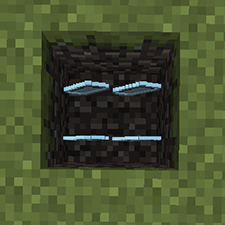
|
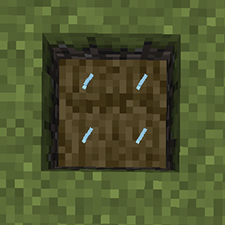
|
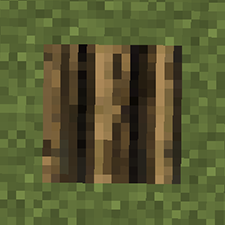
|
| With items placed | With straw placed | With logs placed |
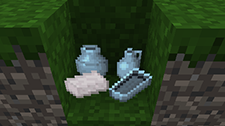
|
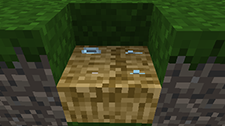
|
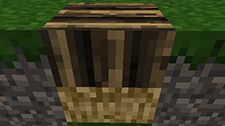
|
| With items placed | With straw placed | With logs placed |
Ceramic items
Finished ceramic items include pottery items, which are used for storage, and molds, which are used in casting of tools, weapons, and metal ingots.
Each time a ceramic item is used, there is a chance of it breaking; this chance is different for each type of item.
Pottery
 Jug
Jug
The jug is used to carry water to quench the Player's thirst. It can be filled by right-clicking on a block of still fresh water (flowing water and salt water will not work), or by placing it in a water barrel set to out. Right-clicking while holding the jug will consume the water in it, replenishing three bars of thirst and completely emptying the jug. Jugs occasionally need to be replaced, as there is a very small chance that the jug will break on each use.
 Vessel
Vessel
- Main article: Smelting
The vessel is a container used both for storage of small items and as an essential component of smelting and casting of Bronze Age metals.
As a simple storage container, it will hold up to 4 stacks of items whose sizes are either small, very small, or tiny. To view a vessel's contents, right-click while holding it; this brings up the inventory screen, and items may be added or removed as with a chest.
A vessel can be stored in a chest or carried in the Player's inventory, even when it contains items. As such it be used to extend both the Player's inventory and the inventory of chests by condensing four stacks into one.
As with other ceramic items, vessels can be placed on solid blocks, or un-placed from blocks, by sneak-right-clicking. This is a useful storage technique, especially early in the game before the Player has obtained a saw to create a chest.
Vessels are particularly useful for storing food items, which will decay at 50% of the normal rate when stored in a vessel.
Molds
- Main article: Casting
Molds are used to cast liquid metal into a solid form. There are two types of mold, shaped and unshaped. Shaped molds are those which have the shape of a tool or weapon, and are used to cast the corresponding item during the Bronze Age. Unshaped molds simply form ingots, which are used to smith tools, weapons, and armor during the Iron Age. See Smelting and Casting for more information about casting with molds.
Configuration
| Option | Default Value |
Description |
|---|---|---|
| general | Miscellaneous options. | |
| pitKilnBurnTime | 8 | The number of hours that the pit kiln should burn before being completed.
|
